Bibliography
- Charles Bauchal, Nouveau dictionnaire des architectes français (Paris: André, Daly fils et Cie, 1887), 842 pp.
Jean-Louis Victor Grisart (Paris, 28 June 1797 - Paris, 14 May 1877) was a French architect.
Jean-Louis Victor Grisart was a student of Jean-Jacques-Marie Huvé, Auguste Guenepin and Huyot. In 1823, he took second place in the Prix de Rome competition at the Ecole des Beaux-Arts in Paris (for a customs house) behind Félix Duban, and then embarked on his professional career.
In 1838, he collaborated with Joseph-Antoine Froelicher for the plans for a gallery of commerce and industry in Paris en 1838 and on the Bonne-Nouvelle store, founded in 1837. Named in 1846 architect of the Caserne (Barracks) des Petits-Pères in Paris, he completed the work in 1860. He designed part of the passage des Panoramas (11 boulevard Montmartre) in Paris, the main body of the building adjoining the entry to the Musée National de la Voiture et du Tourisme in Compiègne (1859), and a hunting lodge near the Saint-Pierre ponds in the forest of Compiègne (1860–61). He was named a chevalier of the Légion d'honneur in 1857.
He lived at 2 rue Crébillon in Paris during the 1830s and then at 20 rue de l'Odéon in the 1870s.

The Palais-Royal is a former royal palace located in the 1st arrondissement of Paris, France. The screened entrance court faces the Place du Palais-Royal, opposite the Louvre. Originally called the Palais-Cardinal, it was built for Cardinal Richelieu from about 1633 to 1639 by the architect Jacques Lemercier. Richelieu bequeathed it to Louis XIII, and Louis XIV gave it to his younger brother, Philippe I, Duke of Orléans. Philippe and the succeeding dukes of Orléans made such extensive alterations over the years, almost nothing remains of Lemercier's original design.

Victor Baltard was a French architect famed for work in Paris including designing Les Halles market and the Saint-Augustin church.

The Salle Le Peletier or Lepeletier was the home of the Paris Opera from 1821 until the building was destroyed by fire in 1873. The theatre was designed and constructed by the architect François Debret on the site of the garden of the Hôtel de Choiseul on the rue Lepeletier. Due to the many changes in government and management during the theatre's existence, it had a number of different official names, the most important of which were: Théâtre de l'Académie Royale de Musique (1821–1848), Opéra-Théâtre de la Nation (1848–1850), Théâtre de l'Académie Nationale de Musique (1850–1852), Théâtre de l'Académie Impériale de Musique (1852–1854), Théâtre Impérial de l'Opéra (1854–1870), and Théâtre National de l'Opéra (1870–1873).
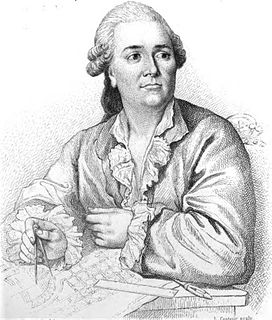
Victor Louis was a French architect, disqualified on a technicality from winning the Prix de Rome in architecture in 1755.
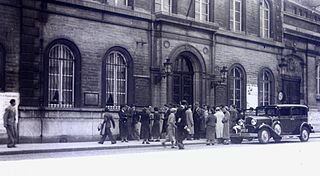
The Académie Royale des Beaux-Arts - École supérieure des Arts de la Ville de Bruxelles (ARBA-ESA), in Dutch Koninklijke Academie voor Schone Kunsten van Brussel, is the Belgian art school, established in Brussels in the Kingdom of Belgium. It was founded in 1711. At the beginning housed in a single room in the city hall, in 1876 the school moved to a former convent and orphanage in the Rue du Midi / Zuidstraat, rehabilitated by the architect Pierre-Victor Jamaer, where the school still operates.

Rue du Bac is a street in Paris situated in the 7th arrondissement. The street, which is 1150 m long, begins at the junction of the quais Voltaire and Anatole-France and ends at the rue de Sèvres.

Louis Candide Boulanger was a French Romantic painter, pastellist, lithographer and a poet, known for his religious and allegorical subjects, portraits, genre scenes.

Henri Sauvage, was a French architect and designer in the early 20th century. He was one of the most important architects in the French Art nouveau movement, Art Deco, and the beginning of architectural modernism. He was also a pioneer in the construction of public housing buildings in Paris. His major works include the art nouveau Villa Majorelle in Nancy, France and the art-deco building of the La Samaritaine department store in Paris.
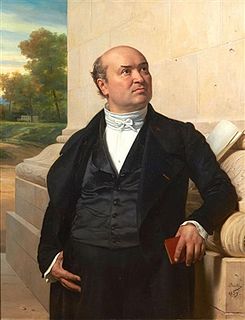
Jean-Nicholas Huyot was a French architect, best known for his 1833 continuation of work on the Arc de Triomphe from the plans of Jean Chalgrin.

Jean Beausire was an architect, engineer and fountain-maker and the chief of public works in Paris for King Louis XIV of France and King Louis XV of France between 1684 and 1740, and was the architect of all the public fountains constructed in Paris that period. Several of his fountains still exist and continue to work. Three streets in the 4th arrondissement of Paris today carry his name: Rue Jean-Beausire, Impasse Jean-Beausire, and Passage Jean-Beausire.
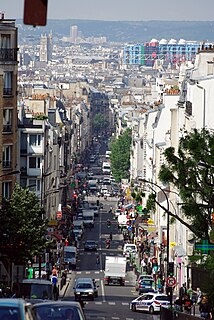
Rue de Ménilmontant is a street which runs through the 20e arrondissement of Paris, France.
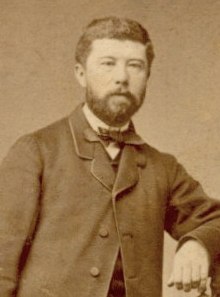
Gabriel-Auguste Ancelet was a French architect who undertook various projects for the Emperor Napoleon III, and later taught for many years at the École des Beaux-Arts in Paris.
Louis-Martin Berthault was a French architect, decorator, engraver and landscape artist.
Charles Hubert Rohault de Fleury was a French architect who was responsible for many public buildings in Paris in the first half of the 19th century.

Jean-Adolphe Beaucé was a French battle-scene painter. Born in Paris, he followed the French army on campaign from 1843 onwards in North Africa, the Middle East and Mexico. He also painted portraits of military figures and produced illustrations for several works by Alexandre Dumas pere such as The Three Musketeers, The Viscount of Bragelone and The Lady of Monsoreau. He died in the Parisian suburb of Boulogne-Billancourt and is buried in the 49th division of the cimetière du Père-Lachaise in Paris.

Jacques Auguste Regnier, sometimes given as Auguste Jacques was a French artist who painted in the Romantic style. He also helped introduce the Troubadour style and was heavily influenced by English literature.
Louis-Denis Caillouette was a French sculptor. His pupils included the medallist Adrien Baudet

The expansion of the Louvre under Napoleon III in the 1850s, known at the time and until the 1980s as the Nouveau Louvre or Louvre de Napoléon III, was an iconic project of the Second French Empire and a centerpiece of its ambitious transformation of Paris. Its design was initially produced by Louis Visconti and, after Visconti's death in late 1853, modified and executed by Hector Lefuel. It represented the completion of a centuries-long project, sometimes referred to as the grand dessein, to connect the old Louvre Palace around the Cour Carrée with the Tuileries Palace to the west. Following the Tuileries' arson at the end of the Paris Commune in 1871 and demolition a decade later, Napoleon III's nouveau Louvre became the eastern end of Paris's axe historique centered on the Champs-Élysées.